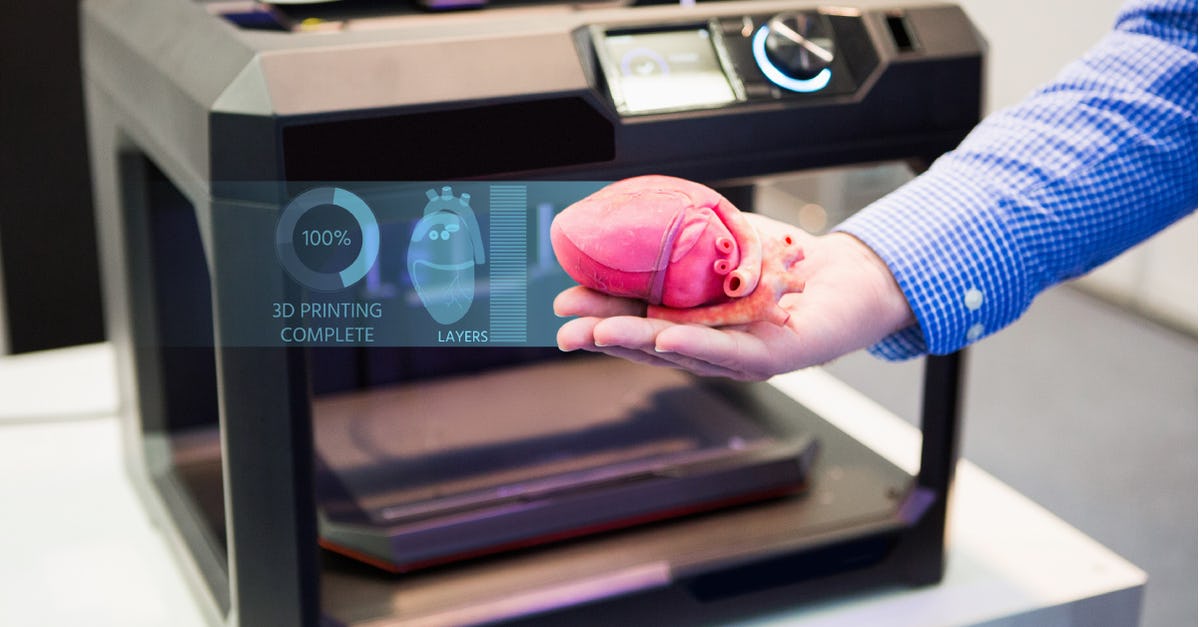3D medical printing in medical applications is expanding very fast & is likely to transform the healthcare sector. 3D printing in the medical field is used as actual & potential & can be structured into numerous classifications such as tissue and organ fabrication; creation of customized prosthetics & implants, & anatomical models; and medicinal research about drug dosage forms, discovery & delivery. It has been applied in medicine from the early 2000s, then after, medical 3D printing evolved by making its use to produce bones, ears, exoskeletons, jaw bone, windpipes, eyeglasses, cell cultures, stem cells, vascular networks, blood vessels, tissues & organs, new prescription forms & drug delivery devices.
3D printing or Three-dimensional printing is a method within which objects are created by blending or depositing materials e.g., plastic, metal, powders, ceramics, living cells, or liquids in layers to create a 3D object. The method is also denoted as Additive Manufacturing (AM), rapid prototyping (RP), or solid free-form technology (SFF). Numerous 3D printing processes make use of different printer technologies, resolution, speeds, & other equipment. 3D objects or models can be built in any shape as determined by the computer-aided design (CAD) file. In an elementary setup, a 3D printer tracks the CAD file instructions to create the substance for an object moving the print head along the x-y plane. The printer then moves on the z-axis to create an object vertically. The 2D radiographic image such as x-rays, magnetic resonance imaging (MRI), computerized tomography (CT) scans can be transformed into digital 3D printing files enabling the complex creation, customized medical & anatomical structures.
3D printing was invented by Charles Hull named as ‘Stereolithography’ in the early 1980s. Later he founded the company called 3D Systems & developed the first 3D printer called a Stereolithography apparatus. Since then many other companies have developed 3D printers which transformed other fields of manufacturing including medicine.

Key advantages of 3D printing in medical applications
- Customization: 3D printing in the medical application can produce customized medical products & equipment such as prosthetics & implants that provide value to patients & physicians. 3D medical printing can generate custom-made implants, jigs & fixtures, surgical tools that impact the surgical time required, patient recovery time, & the accomplishment of surgery or implant. 3D printing technology also allows drug dosage forms, release profiles & provision of dispensing for each patient is customized.
- Cost-efficient: 3D printing enables items to be produced inexpensively. 3D printing as compared to traditional methods of printing is becoming more competitive to run small productions such as small-sized implants & prosthetics, spinal, dental, or craniofacial disorders. Custom 3D object printing cost is minimal with low production volumes of the companies that produce highly complex parts or products with frequent modifications. 3D printing can also reduce manufacturing costs by decreasing the usage of unnecessary resources. For instance, if the pharmaceutical tablet weight of 10 mg can be custom fabricated as a 1mg tablet on demand. Some drugs can be printed in dosage forms that are more cost-effective to supply to patients.
- Advanced Productivity: 3D printing technology is much faster than traditional techniques where products can be generated within several hours. Earlier times, items such as implants & prosthetics required milling, forging & long delivery time. Along with speed, 3D printing medical technology is also improving with accuracy, resolution, reliability & repeatability.
- Democratization: The increasing range of products available in 3D printing is bringing in a decrease in the cost. This enables more people to use 3D medical printers to the extent of design imaginations & produce novel products for personal & commercial use. The 3D printing data files provide a unique opportunity to share with researchers which makes them easily accessible by downloading the (.stl) files from open source databases. This helps them create the replica of the medical model & or device with an accuracy of designs. It was in 2014, that the National Institutes of Health established 3D Print Exchange to promote open-source 3D print files from a database for medical & anatomical models, replicas of proteins, bacteria & viruses, custom labware & so on.
- Training tool: 3D printing plays a significant role in training future doctors & practitioners to prepare themselves for actual complex operations. 3D printing offers visualization of models that appears to be realistic & are exact facsimiles of actual human organs. This makes the practice of doctors, scientists & researchers more effective and accurate. Training of human-like models from 3D printed organs makes the future medical professionals more skillful before performing the actual medical treatment & operations on their patients.
- Intensive care: 3D printers can make low-cost prosthetics for people in villages, war-torn countries, poverty-stricken countries & remote regions where they cannot afford to purchase prosthetics. 3D printers provide an affordable solution & make it easier & cheaper to transport the delivery of medical equipment.
- Reduction in Cost & Time: 3D printing enables to 3D print kinds of medical device & labware equipment. 3D printing makes it possible to print tough plastic parts of the equipment which drastically saves costs & time of waiting to receive a device from external or third party suppliers. Thus, the manufacturing process & applications become easier & readily available with low-income 3D printed medical material & equipment.
As 3D printing in medicine is becoming more advanced with technologies, it is expected to play a significant role in personalized medicine, with customization in organs, nutritional products & drugs where patients will be able to reduce their medication stress to one polypill a day & this would help patient adherence. For more information on 3D Medical Animation visit the website.

